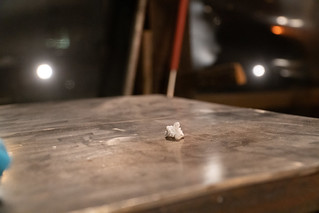22 October 2021.
Photos: https://www.flickr.com/photos/csefkotamas/albums/72157720075121822
Introduction
Two weeks ago we read a conversation with Silo where he talked about the glass workshop. In it he mentioned Murano glass as a reference. Claudio gave us a recipe that was found written on a wall in Murano. We also searched the internet for glass recipes from Murano.
Preparation
We met in the Park in the early afternoon. First we looked at the recipes we had been given and found, and agreed that we would try to make a good quality "base glass" containing only the three main ingredients: quartz, soda and lime. We agreed on these proportions based on a recipe from Claudio: 65% SiO, 23% Na2O, 12% CaO.
As the recipes refer to oxides (calcium oxide, sodium oxide, silica), the available raw materials (limestone powder, washing soda, quartz flour) had to be converted to weight based on the weight ratios.
Basis for the calculation of the quantities:
Na: 23g/mole, C: 12g/mole, O: 16g/mole, Ca: 40g/mole, H: 1g/mole
Quartz sand: this is 100% SiO2.
Washing soda: sodium carbonate (Na2CO3) + 10 molecules of crystal water, i.e. 2*23 + 12 + 3*16 + (10*18) = 286g of Na2CO3 -> 2*23 + 16 = 62g Na2O
Na2O / washing soda = 1:4,6
Limestone powder: calcium carbonate (CaCO3), i.e. 40 + 12 + 3*16 = 100g CaCO3 = 40 + 16 = 56g CaO
CaO / limestone powder: 1:1,78
So if we want to produce 1 kg of glass with a ratio of 65% SiO - 23% Na2O - 12% CaO, we need
650g quartz sand, 1058g washing soda, 213g limestone powder
The experiment
In the workshop we took out the old, small furnace and replaced the crucible with a new one. We then measured out the exact quantities, mixed them in a bucket, put some of the mixture in the crucible and started the furnace. We didn't want to put all of the material in at once, so that the foaming from the gas formation wouldn't cause the material to come out of the crucible.
9:30: We started the furnace
21:30: 980 degrees C, still dust on top, starting to come together underneath.
21:51: 1030 C degrees, we noticed that there is a "glass drop" in the middle, a small hard glass-like part.
22:15: 1050 C degrees, we put some more material on top, about up to 3/4 of the crucible. The new material starts to change very quickly (in minutes).
22:31: 1080 degrees C, collapsed, foam-like, clumped together, separating from the crucible wall, soft, sticky. You can see the gas shots. Sample #2.
22:55: 1100 degrees C, collapsed by half, added more material. Sample #3 of foam.
23:18: 1130 C degrees. As the volume in the crucible has dropped again, we add another portion of powder. The top is foamy, the bottom is hard.
0:03: 1175 C degrees, added the last portion of powder. The foam has changed. It is no longer solid white, but seems to be more "watery".
0:31: Bubbles have disappeared, now looks like boiling water.
0:37: The stick now goes down to the bottom of the crucible in this boiling substance.
0:50: 1166 degrees C. It had collapsed a lot (about half way down the crucible), the material is still, no boiling, tiny bubbles on top. The top is clear,but white underneath. Sample #5
1:20: Same watery appearance. We Stirred and it seems chewy.
1:51: Top is clear but watery, we cannot make a drop with it either.
The suspicion has been raised that the washing soda does not contain crystal water, which completely changes the ratios. An experiment was carried out: exactly 5 g of washing soda was weighed out in a small bowl and placed at the entrance to the furnace, where it was heated up to about 900 °C. After half an hour, oxidation took place and gases were released from the powder. After the reaction, the weight was only about 2 grams less, i.e. the powder did not contain any crystal water.
The proportions were then recalculated based on the fact that the original powder mixture contained 622 grams of Na2O instead of 230 grams. We mixed 1100g of quartz and 362g of limestone powder in a plastic bowl (this was the amount of the other two materials that had to be increased to get the originally planned proportions).
1:12: We added a portion of the new powder to the crucible. It's like pasta, not yet homogeneous.
2:34: 1335 degrees C. We stirred, it is dense, gooey, quartz not melted yet.
2:51: 1315 degrees C. Added another portion of the new powder.
3:00: Still not all the new powder is added. The mass is more homogeneous, but the last portion is still powdery.
3:20: We stop because we're tired and the original experiment didn't work anyway because of the wrong proportions. Sample #7










Comments
Post a Comment